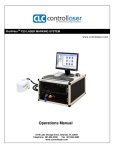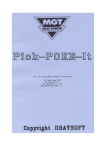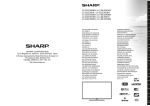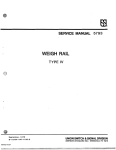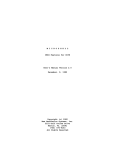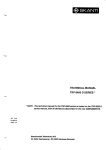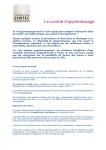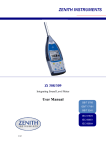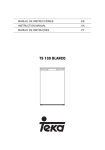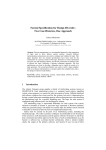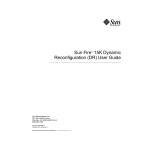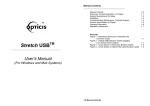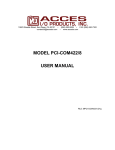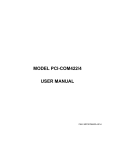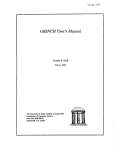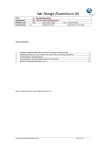Download 8085/Z80 ASSEMBLER USER`S MANUAL
Transcript
,
,,,~,.,,,,
(
8085/Z80 ASSEMBLER
USER'S MANUAL
XASMB5 Assembler Version 1.04 Manual Revision 1.1 C22-0ec-B3) Copyright (C) 1983. 1984 Avocet Systems. Inc. All rights reserved. The name AVOCET and the bIrd logo are trademarks of Avocet Systems. CP/M is a trademark of Digital Research. MS-DOS is a trademark of Microsoft Corp. VEDIT is a trademark of Compuview Products. WORDS TAR is a trademark 01 Micropro. AVOCET SYSTEMS. INC.
804 SOUTH STATE ST.
DOVER, DELAWARE
19901
(302) 734-0151
·~llD.1e
Chapter 1
1.1
1.2
1.3
1.4
1.5
1.6
1.7
Chapter 2
Introduction
'Who This Manual Is Written For
Hints For Novices
Recommended Reading
System Requirements
Overview of Assembler Operation
Hov Fas t Is It?
Syntax Notation In This Manual
Getting Started
2.2
XASM85 Command Lines
2·~4
2'.5·
2.6
Cbapter3
3.1
3.2
3.3
3.4
3.5
3.6
3.7
3.B
3.9
3.10
Chapter 4
4.1
4.2
4.3
4.4
4.5
!J..6
4.7
4.8
1-1 1-1 1-2 1-3 1-3 1-4 1-5 Bow To Operate The Assembler
2.1
2.3
01 l.,;oot;eot;B
Command-L1ne Flags
Assembler Command Line Examples
Summary of Defaults
Aborting An Assembly
2-1 2-1 2-2 2-2 2-4 2-4 Syntax of Statements and Operands
Statements
Examples of Statements
Ident1fiers and Symbols
Numbers
Character Constants
Location-Counter Reference
Arithmetic Expressions
Operators Allowed In Expressions
Evaluation of Expressions
Forward References
3-1 3-2 3-3 3-3 3-4 3-5 3-5 3-6 3-B
3-10 The B085/ZS0 Instruction Set
CPU Registers
Immediate and Direct Addressing
Indexed Addressing
B-Bit Load Instructions
16-Bit Load Instructions
Push and Pop :nstructions
Zxchange Instructions
Block Move and Compare Instructions
4-1 4-2 4-2 4-3 4-4 4-4 4-4 4-5 ••
'
/
/
/
" XASM85 User I s Manual
Table ot Contents 11 Continued
-""
4.9
4.10
4.11
4.12
4.13
4.14
4.15
Chapter 5
8-Bit Arithmetic Instructions
Control Instructions
16-Bit Arithmetic Instructions
Shirt and Rotate Instructions
Bit-Manipulation Instructions
Jump, Call, and Return Instructions
Input and Output Instructions
4-6
4-7
4-7
4-8
4-9
4-10
4-11
Pseudo-Instructions
Storage Definition
Program Origin
End of Program
Symbol Definition
Offset Assembly
Conditional Assembly
General Listing Control
Title and Subtitle
External Source Files
Target Microprocessor Validation
5-2
5-4
5-5
5-6
5-7
5-8
5-9
5-10
5-11
5-12
Chapter 6
Error Handling
6-1
Chapter 7
Fonnat ot Messages and ListiIIgs
5.1
5.2
5.3
5.4
5.5
5.6
5.7
5.8
5.9
5.10
7.1
7.2
7.3
7.4
7.5
Appendix
Appendix
Appendix
Appendix
A
B
C
D
Assembler Sign-On Banner
Final Messages
Page Headings
Line Headings
Symbol-Table Listing
7-1
7-1
1-2
7-2
7-3
Messages and Flags
Object File Format
Source File Preparation
Estimating Memory ReqUirements
A-I
B-1
Er~or
C-1
D-l
XASM85
User's
CHAP'l"ER 1.
Ma.nual
Page 1-1
DTRODUCTIOJl
This manual describes the features and operation of XASMS5,
Avocet Systems I assembler for the S085 and ZSO microprocessors.
In the introduction, you'll find an overview of the assembler's
features, system requirements, and performance.
There's also a
list of skills and knowledge you should have before using the
assembler, and a description of the syntax notation used in the
rest of the manual.
---
1.1 Who This Manual Is Written For
--
This is a reference manual, written for experienced assem
bly-language ]ll"ogrammers. It presents the information needed to
use the assembler, in what we think is a clear and readable form.
The manual is not intended to be a tutorial, but there are oc
casional tutorial asides for the benefit of newcomers. Also,
we've tried to provide plenty of examples, to help you answer
your own questions about how things work.
In writing this manual, we assumed that you:
-are reasonably familiar with your computer and its oper
ating system (CP/M, MS-DOS, or equivalent).
-have a text editor, and know how to use it.
-know the architecture and instruction set of the 8085
and/or the Z80.
-have programmed in assembly language before.
1. 2 Rints For Novices
If you lack any of the prerequisites listed above, you
should plan ~c do some supple~ental reading before you begin
t:s:'r.g assembler (or a't the serne 'time, if you're really ambl
~1ous).
~€ ~est of this sect~c~ discusses tte prerequisites !~
more de~eil, and the next section suggests some books to read.
•
~
XASM85 User's Manual
Page
1-2
OPERATING SYSTEM: You can run the assembler without knowing your
operating system intimately, but you may need to use some of its
utility programs when the time comes to test or download an
assembled program. For instance, CP/M's PIP and DDT programs are
particularly usefUl; COpy and DEBUG are the equivalent commands
under MS-DOS.
TEXT EDITOR: There's no way you can use the assembler vithout
one; you have to have some way to get assembly-language programs
into a disk file. If you're really new at this, and haven't used
an editor before, you'll just have to bite the bullet and learn.
While ve're on the
full-screen variety,
ted editors such as
although they can be
subject, your editor should be one of the
such as VEDIT or WORDSTAR. Teletype-orien
CP/M's ED are guaranteed to be frustrating,
used if nothing else is available.
THE 8085 CHIP:
You viII have to knov the 8085's architecture and
instruction set before you can vrite programs for it. Hovever"
you need not commit the entire instruction set to memory at once;
learn a fev instructions at a time, and begin using them. The
assembler itself can help you, as it viII reject most illegal
instruction/operand combinations. This in turn should send you
scurrying back to the 8085 Programming Manual (or equivalent) for
reviev; eVentually, you'll remember vhat's legal.
ASSEMBLY PROGRAMMING EXPERIENCE: If you haven't used an assem
bler before, don't panic; there's alvays a first time. Basic
notions like "symbol", "expression", and "pseudo-instruction" may
be unfamiliar to you, but you can probably make sense of them by
reading this manual carefully. To fill in the gaps and see hov
these elements fit together, read or skim one of the books listed
belovo
1.3 Recomnended Reading
A visit to your local computer store or university bookstore
should turn up any number of books on the 8085 and Z80, and on
the CP/M and MS-DOS operating systems. As a start, you might
look at the ones listed here:
Fernandez, Judy N., and Ruth Ashley: 8080/8085 Assembly
Language Programming.
John Wiley & Sons, 1981
Spracklen, Kathe: Z-80 and 8080 Asse::nb:z
P:!-ogr'c.::rming. Hayden Bock Co., :nc. Lars er: , Ti :.us, & 'l'itus:
Books.
w.
Lan'PlB.6..~ Hovard
XASM85
User's
Manual
Page
1-3
I
I
In addi tion, \Ie recommend the data books a.nd programming
manuals available from manufacturers of the 8085 a.nd Z80 chips
(eg. Intel~ Zilog and Mostek). Even if you are experienced, it
may be useful to have one of these on hand as a guide to the
instruction set.
1. 4
SysteJll R!9,uirements
XASM85 is presently available under three different operat
ing systems: CP/M-80, CP/M-86, and MS-DOS (PCDOS). There 1s a
different version for each operating system. The CP/M-80 version
works with CP/M versions 1.3 and higher, and also with extant
versions of CDOS and TurboDos. It has been used successfully
with several other CP/M look-alikes~ though we cannot guarantee
compatibility vith unknown systems.
Under CP/M-80, XASM85 runs on 8080-~ 8085-~ and Z80-based
computers. Approximately 11K bytes of memory are required for
the assembler and internal buffers. Additional memory is used to
store the assembly-time symbol table. Although the assembler can
probably be run in a 32K system, we recommend 64K of memory.
)
Under CP/M-86. MS-DOS, or PCDOS, XASM85 runs on 8086- and
8088-based computers. Approximately 20K bytes of memory are
required, with additional memory for the symbol table. The
computer should have at least 64K of memory.
For all versions, at least one disk drive is required. We
strongly recommend that you have a second disk drive and a prin
ter.
1. 5
Overview Of Assembler Operation
XASM85 accepts assembly language text from an input file on
disk (often referred to as the source file). It generates two
output files: The object file contains the machine language
program produced by the assembler. The listing file contains an
assembly listing - a copy of the input text, annotated to show
the instruction codes and data generated by the assembler~ and to
indicate any errors detected. It also contains a tab:e showing
all symbols defined in the input text, and ~he values essigned to
them.
)
The sot:.:;:'ce language !";So:S standa~d In-:el ::r.e:ncnics ;:::' -:-:e 8085
instruction set. :::n addition, !t. includes Intel-st:::,= I."TDL")
~nencn!cs ;:or the exte~~ed ins~~uction se~ of the :50.
.
~
)
XASM85 User's Manual
Page
1-4
The assembler normally paginates the assembly listing and symbol
table. That is, it breaks them up into numbered pages for
output to a printer. Each page begins vith a page number, tItle,
and subtitle.
The object file is in Intel "HEX" format. ThIs format represents
binary instruction codes and data as hexadecimal numbers in
printable form. It minimizes file size by eliminating the need
to store large blocks of initialized addresses, and it provides
internal checksums to guard against file transmission errors.
DurIng operation, tbe assembler displays certain information on
the computer console. A sign-on banner, containing the assembler
name, version, serial number, and cop,yright message, is displayed
at the beginning of each run. Any source lines which contaIn
errors are displayed as tbey are encountered, In assembly listing
format. At tbe end of the run, the assembler tells you bov many
source lines contained errors, what fraction of the memory av
aIlable at assembly-time vas actually used, and the higbest
object address for which code or data vas generated.
1.6 How Fast Is It?
)
XASM85 assembles approximately 4800 lines per minute vhile
generating both an object file and an assembly listing. Without
the assembly listing, this increases to 5900 lines per minute.
These figures vere obtained by using the CP/M-80 version of
the assembler, running under CP/M VerSion 2.2 on a 4 MHz. Z80
vith a hard disk. The input file for the test vas 2371 lines
long, and defined about 100 symbols. The speed computation
inclUded the time required for the operating system to find and
load the assembler, but not the time to re-boot the operating
system upon completion.
Please note that assembler speed vill vary substantially
vith the speed of the host computer. In particular, the assem
bler spends much of its time reading and writing disk files, and
$0 is sensitive to disk access times and data rates.
In general,
you should expect it to be significantly slover with floppy disks
than with the hard disk used in our tests.
)
Page 1-5
XASM85 Us er • s Manual 1.1
Syntax Notation In This Manual
Throughout this manual, the folloving notation is used to
descr1 be the syntax of the assembly language and of assembler
commands:
<
)
Angle brackets enclosing lover-case text indi
cate that you must enter an item of a type
defined by the text. For example, <expr> means
you must enter an arithmetic expression.
<CR) Angle brackets enclosing Upper-case text indi
cate that' you must press tbe key specified by
the text. For example, <CR) means the RETURN
key.
Brackets indicate that the enclosed item is op
tional.
Capital letters indicate items that must be
entered exactly as shovn except for case. That
is, you may enter the same letters in lovercase.
CAPS An ellipsis indicates the preceeding item or
sequence of items may be repeated zero or more
times.
)
space Where a space is shovn, at least one space or
tab character is required. Spaces and tabs may
be used in combination, as many as you visb.
other Other characters should be entered exactly as
shoVD.
For example,
DB
<expr>L,<expr> ••• J<CR)
means that you must enter the letters DB or db, folloved by at least
one space or tab, folloved by one or more arithmetic expressions
and the RETURN key. If you enter tvo or more expressions, they
must be separated by commas.
Since it is understood that every line in a source file ends v1th
2.
S
RETURN,
Wte!1
)
",Ie
l..t::l:
ge~~:--~.l:!.y·
o!!lit the (CR) wte::
desc~:bing
"the
cu!'::: e language.
are pre5en1:::':-:g an example or specimen cf' ar: c.ssembly
construc:', 'A';2 ·.... ill ~enerally 5::0'.1 it ::-: bclc.:;ace, as
ca.r: 'De seer: ::-: the pre:::;2ed.::'ng parag-:-aphs.
·.Ie
lar,~'c:.age
•
,,,,
XASM85 User' s Manual
Page 2-1
BOW TO OPERATE THE ASSEM:BLER
CHAPl'.KR 2.
This chapter describes the mechanics of using XASM85: how to
invoke it, how to specify the file to be assembled~ and how to
control the generation and format of output files.
2.1
Getting Started
You can get started using the assembler even before you
learn the details of its command-line syntax. You need only
type its name, lASH85, followed by the name of the source
file which you want processed. For example, to assemble the
file GRINCH.ASH, you would type
XASM85 GRIlfCH<CR>
This instructs the operating system to start the assembler
running,. and to tell it to use GRINCH.ASM as the source nle
(the .ASM part is supplied by the assembler if you don't
tell it otherwise).
)
2.2
XASM85 Command Lines
A complete XASM85 command line looks like this:
XASM85 l<drv>:J<name>l.<ext>1 L<drv>:J l<flag) ••• J<CR>
Where:
<drY> )
is a single character specifiying a disk
dr 1 ve (eg. A, B, etc.). The first <dry>
specifies the drive on which the input file
is located. The second <drv> specifies the
drive on which the output files are to be
placed. Either of the <drv>: specifiers may
be omitted, in which case the current drive
is used.
(name> is a string of up to 8 characters, which is
the name Qf the input file
<ext) repres ents a fi le extens ion of up -::'0 three
c~aracte~s.
:t may be omit~ed, :n ~hich
cas e the ~:':e ex:.ens ion "AS r·::' , i s ~s eGo
XA.SM85 User t s Manual (flag> )
Page 2-2
is one of the single-character commands
shovn belov, vhich control the operation of
the assembler.
2.3 ColllD8Ild-Line:nags
The flags,
)
.
if
supplied, control various options as follovs:
L
Listing Only (turn off object file)
o
Object Only (turn off assembly listing completely) X
Turn off assembly listing (symbol table not suppressed) Y
Turn off symbol table (assembly listing not suppressed) C
Send listings to the console. P
Send listings to the printer. N
Suppress pagination of assembly list1ng; ie. no page headings or page ejects .
Q
Quiet.
Turns off assembler sign-on banner.
Flags may be used in combination.
For example, specifying
"LeN" suppresses the object file, directs the listing to the
console, and suppresses pagination.
belovo
More examples are shoyn
2.4 Assembler Command Line Examples
Example 1.
Command Without Flags
XASM85 GRI1lCH<CR)
The file GRINCH.ASM, located on the current drive, is
assembled. Tvo output files are generated: GRINeR.HEX
contains the object code, and GRINCR.PRN contains the
assemcly listing and symbol table lis~:ng.
)
••
XASM85 User's Manual Example 2.
Page
2-3
Complete Source File Specification
XASH85 C:GRIBCH.FOO<CR)
The file GRINCH.FOO, located on the drive C, is assem
bled. The output files are the same as in Example 1,
above. I f we had left of the "C:", then GRINCR.FOO
would have been sought on the current drive.
Example 3.
Sending output files to a different drive.
XASM85 A:GRIliCB B:(CR>
The file GRINCH.ASM. located on drive A. is assembled.
The output files are the same as in the previous ex
amples, but are placed on drive B.
Example 4.
Sending the listing file to the printer.
:IAS.M85 GRIliCB PL<CR>
)
The file GRINCH.ASM is assembled, as berore. This
time, the listing file (containing the assembly listing
and symbol table listing) is sent to your computer's
1ST: device, which presumably is tbe line printer. In
addition, because we have included the "V' flag, no
object file is generated.
Example 5.
Getting A List Of Error Lines Only
XASM85 GRINCR LXI(CR>
GRINCH.ASM is assembled, as before. This time, we have
turned off the object file v1 th "L", suppressed the
assembly listing wIth "X", and suppressed the symbol
table listing with "yOI. You might expect that the
assembler would produce no output at all. Hovever, the
assembler always lists lines wbich contain errors, even
if the listing is suppressed. Thus, the command line
shown here will produce a .PRN file containing only
those lines in which errors occurred. Since pagination
is irrelevant here, you will probably want to suppress
:t also, thus:
XASM85 GRINCR
)
LXYN(CR)
~2-4
XASK85 User's Manual The order in which the flag characters appear is unim
portant- the command
XASM85 GRIllCH IXLI'(cn>
would have the same effect. Finally, since "0" is
equivalent to writing ''X" and "Y", we could have wri t
ten the command yet another way as
XASM85 GRIffCH OLN(CR)
2.5 Sumuary
of' Def'auJ.ts
If you don't specify otherwise in the command line, the
assembler will behave as follows:
The source (input) file is sought on the current drive,
and has extens ion ".ASM".
An object file is produced.
rent drive.
It
placed on the cur
An assembly listing and a symbol table are generated.
They are placed in a file on the current drive, with
the same filename as the input file, and with extension
)
". PRN" •
2.6
Aborting An Assembly
You can terminate an assembly at any time by striking a
control-C at the console.
This causes an exit to the
operating system.
)
.,;
XASM85 User's Manual
Page 3-1
!
CHAPrKR 3.
SYNTAX OF STA'I»IKNTS AND OPKRARIS
An assembly-language program consists of a sequence of
statements, each occupying one line of the source file. A state
ment comprises four fields, not all of which need be present:
label, operation, operand, and comment. All statements are div
ided into these same fields in the same way, and thus share a
common syntax. The allowed contents of the operand field vary
according to the operation specified, but all operands are formed
from a common set of elements: symbols, numbers, strings, arith
metic operators, etc.
Operations, and therefore statements~ are of two kinds:
instructions and pseudo-instructions. This section describes the
syntax common to both kinds of statements, and the syntax of the
elements used to form operands. The two subsequent sections
describe instructions and pseudo-instructions in detail.
3.1 Statements
Each line of the source file contains a single assem
bly-language statement.
A statement consists of four
fields: label field, operation field, operand field, and
comment field, arranged thus:
L<label> J l <operation>
l <operand>••• J J l ;<comment> J
The operation field contains a mnemonic symbol for an
8085 instruction or an pseudo-instruction (assembler direc
tive). The exact interpretation of the label and operand
fields varies according to which instruction or directive is
present.
The label field, if present, consists of an identifier
optionallY followed by a colon. Using an identifier in the
label field defines it as a user symbol and gives it a
value. Ordinarily, this value is the address of the first
byte of the instruction or data generated by the statement;
that is, the symbol labels the current location. However,
there are a few pseudo-instructions which assign" other val
ues to the symbol, independent of the current add!'ess. EQU
fs an exa~~:e o~ 3UC~ a pseudc-:nstruction.
)
The o~2"a~d ::el~ consists of ze!'o or more c;erands; if
there are ~·.ro or !':lore, then t!':ey are separated 1;;y conmas.
The::-e are "everal ki::.ds of o:;,:erands- !'egiste!'s, ari t,hmetic
express~or,s, and ctaracter s~rings, to name a :ew.
Just
Page 3-2
XASM85 User's Manual
..
which ones are allowed, and how many, depends on the opera
t ion speci fied.
The comment field consists of any sequence of printing
characters t preceeded by a semicolon. It is intended for
human consumption, and is always ignored b,y the assembler.
The fields are separated by whItes pace; ie. by any
combination of blanks and tabs. We suggest USing tabs only.
This not only saves space in the source file, but it allows
you to line up the fields in vertical columns, making your
program easier to read.
All of the fields are optional, except that operands
may not be present unless there is an operation. Fields may
begin in any column, except that
-The label, if present, must begin in the first column.
-At least one blank or tab must precede the operation.
Blank lines are specifically allowed; they are treated as
comments.
)
3.2
~les
Example
Qr statements
l.
Line consisting only of a comment:
;this is a comment
Example 2.
Instruction with label, operands, and comment:
;Load A :from B
Example
Line conSisting only of a label:
FOO:
Example~.
Line consisting only of an instruction:
LD
::xamnle 5.
?seudo-:'nstruc~ion
MOO
)
BL,1234H
EQU
5
definir.g a sytlbol:
XASK85 User's Manual
3.3
Page
3-3
Identi:fiers and Szu!bols
An identi fi er is a 'W"ord or name, such as LDA, GRINeR,
or A002. There are several kinds of identifiers in the
assembly language: Mnemonics are the names of instructions
and pseudo-instructions. Operators are the names of arith
metic functions, such as MOD (the remainder function) and
XOR (bitvise exclusive-or). Symbols, as ve use the term,
are identifiers representing registers, addresses or numeric
quantities, 'W"bich may be used 1n forming operands.
Mnemonics, operators, and some symbols (for example the
names of the 8085 registers), are pre-defined by the assem
bler. All other symbols must be defined by your program.
You can define an identifier as a symbol by USing it as
a label, or by using it in the label field of an EQU or DEFL
statement. Identifiers may contain any of the folloving
characters:
A•• Z
a •• z
0 •• 9
$
?
The first character of an identifier may not be a digit or
dollar sign.
)
An identifier may consist of as many characters as you
'W"ish, but only the first 8 characters are significant. That
is, t'W"o identifiers are the same if their first eight char
acters are the same. Also.. the assembler makes no distinc
tion betveen upper and lower case; for example, abed and
AOCD are the same identifier.
All of the pre-defined indentifiers are reserved; that
is, you may not redefine them as symbols.
4 Bwnbers
A number consists of a sequence of digits, possibly
including the hexadecimal digits A through F, optionally
preceeded or folloved by a character specifying the number
base (radix). The first character must always be either a
decimal digit (O~9) or a base specifier.
)
XASM85 User's Manual Page
3-4
.
The base speci:fiers are:
base
leading specifier
trailing speci:fier
2
%
B
8
@
o or
$
H
16
Q
I:f no base is specified, then base 10 is assumed.
The :folloVing examples all represent the number 127:
127 @177 l77Q $7F 7FH %1111111 lllllllB )
Since a number must begin with a decimal digit or
leading base specl:fier, you must be careful in writing hex
constants that begin with a letter. For instance, the
number 255 may be vri tten as $FF or OFPH, but not as FFH.
The latter vould be treated as a symbol by the assembler,
resulting in a '1]" (Unde:fined Symbol) error.
3.5 Character Constants
A character constant consists o:f one or tvo characters
enclosed in single or double quotes (' or "). The single
quote may be used as a character betveen double quotes, and
vice-versa.
Character constants are evaluated as 16-bit integers,
vith each character converted to its ASCII code. For a
single-character constant, the high-order Qyte is zero, and
the lov-order byte is the character code. For a tvo-charac
ter constant, the high-order byte o:f the value contains the
:first character code, and the lov-order byte contains the
second.
~us,
the folloving are equivalent:
'A I
)
"A"
and
'AB' "AB" and
41H
4142H
XASM85 User's
3.6
Manual Page
3-5
Location-Counter Reference
The assembly-time location counter, vhlch keeps track
of addresses in the generated code, may be referenced by the
special symbol $ (dollar sign). The value of this symbol is
the address of the first byte of code or data generated by
the current statement. Thus, for example, the statements
ORG
JJW
JJW
4455H
$,.$ $,$ vould generate the folloving sequence of (hex) bytes, (rem
ember that the loy-order byte comes first):
55 44 55 44 59 44 59 44
3.7 Arithmetic !!;pr:essions
)
Symbols, numbers, character constants, and location
counter references all evaluate to 16-bit integer values.
Wherever such a value is alloyed, you may also use an arith
metic expression, composed of one or more of these elements connected by operators (:functions). As you might expect, the set of :functions includes +
• and / (addition, subtraction, multiplication, division).
It also includes many other :functions, such as modulo (rem
ainder), left and right shift, and relational operators.
All the functions except + - • and / are represented by
identifiers, and must be sep3.rated from their arguments by
at least one blank or tab.
Most of the operators treat their operands as 16-bit
unsigned quantities. Hovever, tvos-complement negation,
-----represented· by -a -unary-minus -5 19n;-t5 -alloved: Negattve'----' -- -.•
quantities from -32168 to -1 can thus be vritten. They viII
give the expected results vhen added or subtracted from
other quantities. Hovever, no overflov checking is perform
ed, and the results of other operations (including multipli~
cation, division. and comparisons) do not take arithmetic
sign into account.
For example, -1 is equal to OFFFFH, the
-t,,,,o's cGt'\plement of OOCIH.
Thus,
-: +
5 =4
as expected. but
)
XASM85 User's Manual Page 3-6
-1 LT 0
is an unsigned comparison of FFFF with 0, and is thus FALSE.
3.8
Qperators Allowed In Expressions
Ari th1lletlc Operators
+
Sum
Difference
unary +
+x is defined as O+x
unary -
-x is defined as
*
Product (unsigned)
/
Quotient (unsigned)
MOD
Remainder (unsigned).
x MOD y gives the remainder of x/y
)
o-x
Shirt Operators
~
SHL Binary left shift. x SHL y yields x shifted
left y places (ie. x multiplied by 2Y )'
SHR Binary right shift. logical.. x SHR y yields
x shifted right y places (ie. x divided by
2Y). High-order bits are zero-filled.
- - , -,---1t-the-right a.rgument '1s-negatlve;-thenthe direction or-the -.
shift is reversed.
4
!2:!:e-Extraction
)
~tors
HIGH Retl1:":1s the value of the ::10st signif:!.cam ~yte of
its argument.
LOW Returns the value of the least significar.t byte
of ::. ts argument
"
:IASM85 User' s Manual Page 3-1
HIGH and LOW are unary operators, taking an argument on the
right. For example: HIGH 1122H 1s IlH, and LOW 1122H is
22H.
Boolean
~tors
NOT Unary logical negation.
in its argument.
Complements all the bits
AND Logical product; ie. each bit of the result Is
obtained by AND1ng together the corresponding
bits in the arguments.
OR Log1cal swn.
XOR Exclusive-OR.
These are all bitwise operators; that is, the same operation
1s performed on each operand bit position.
For example: NOT 0 1s
lOIB AND
lOlB OR
lOIB XOR
lOlB XOR
OFFFFH OIOB
OIOB
OIOB
lOOB
is
is
is
is
0
IllB IllB OOIB Relational O perators
These perform unsigned 16-bit compirisons of their operands,
returning 1 for TRUE and 0 for FALSE.
For comparison x R y, where R is a relational operator, the
results are as follows (iff means "if and only if"):
EQ
NE
I.E
LT
GE
GT
)
TRUE 1ff
TRUE iff
TRUE 1ff
TRUE iff
TRUE iff
TRUE iff
x
x
x
x
x
x
and yare equal
and y are not equal
is less than or equal to y
1s strictly less than y
is greater than or equal to y
is strictly greater than y.
XA5M85 User's Manual
)
Page
3-8
3.9 Evaluation of' ExE!:essions
The order in which parts of an arithmetic expression
are evaluated is governed by E!:ecedence values assigned to
the operators. Precedence may be thought of as "tightness of
binding"; operators with higher precedence bind more tightly
to their operands, and thus are evaluated first. For example,
3
*
5 + 4
is interpreted as
(3*5) + 4
because the multiplication operator has higher precedence
than the addition operator. In general, precedence values
have been chosen to cOincide with your intuitive notions of
how expressions should be read. A table of relative opera
tor precedences is given on the next page.
When two operators have the same precedence, the ex
pression 1s evaluated from left to right. Thus,
)
4-1+2
1s interpreted as
(h-l)+2
You can override the assumed order of evaluation by
USing parentheses in the normal way. In fact, we recommend
that you do so 1n all but the simplest cases. Not only will
this leave no doubts about what you meant, but it will
prevent portability problems should you later use a differ
ent assembler. (other assemblers may assign different
relative precedence to the more obscure operators).
)
XASM85 User's Manual.
;
TABLE 1.
RELATIVE PRECEDENCE OF OPERATORS
Groups of operators are shown in order of descending prec
edence. All operators in a group (ie. on the same line)
have the same precedence.
(HIGHEST PRECEDENCE)
unary +, unary -
HIGH
LOW
*
/
MOD
+
-
EQ NE
LT
SHR
LE
SHL
GT
GE
NOT
AND
OR
)
)
XOR
(LOWEST PRECEDENCE)
DSM85 User t s Manual
)
Page 3-10
3.10 Forvard Rererences
A for"ard reference is a reference to a symbol vhich is
not defined until later in the source program. For example,
take the folloving program fragment:
DS
GRINeH
EQU
DS
GRINCH+I
7
GRINCH+I
The use of GRINeR in the first DS statement 15 a for"ard
reference, since GRINeH has not yet been defined vhen this
statement is encountered. The use of GRINeR in the second
DS is not a forvard reference, as the statement defining
GRINeR bas already been encountered.
)
There are a number of places in the assembly language
"here forvard references, and expressions containing them,
are specifically prohibited. The general rule is that a
forvard reference is not alloyed vhere the value of the
expression affects the location counter or controls the
number of bytes of code generated. Most cases vhere this
occurs are in pseudo-instructions; if' forvard ref'erences are
not allo"ed, this viII be stated In the p;eudo-op descrip
tion. The assembler viII report an ifF" error vhenever it
finds an illegal forvard reference.
To further clarify the notion of a forvard reference,
consider the folloving statement:
JMP
$+5
Tbe expression $+5 is not a forvard reference, even though
the jump is forvard, because the value of the location
counter ($) is already knovn "hen the JMP statement is
processed.
)
Page 4-1
XASM85 User' s Manual
j
CHAPmR
4.
THE
8085/Z80 IliJSf.mUCTIOIl SET
This chapter describes the assembLY-language syntax of 8085
and Z80 instructions. A complete discussion of 8085/Z80 archi
tecture and instruction semantics (ie. what the instructions do)
is beyond the scope of this manual; for this information, see any
of the books mentioned under Recommended Reading in the Introduc
tion.
4.1
CPU Registers
The assembly language includes pre-defined symbols for all
of the CPU registers that may be referenced in instructions.
These symbols do not have numeric values, and may be used
only where a register is specifically allowed. However,
their names are reserved; they may not be re-defined as user
symbols.
The 8-bit registers are:
)
ABC
D E
H L
The names
B D H
are also used to refer to the 16-bit register pairs
consisting of Be, DE, and HL. Other 16-blt registers are
named as follows:
SP PSW X Y
Also, the memory location addressed by the contents of the
HL register pair may be referred to by the name M, which
behaves syntactically like an 8-bit register name (in most
contexts) .
)
Page h-2
XA.SM85 User' s Manual
)
h.2
~ate and
Direct Address1ng
Direct addressing uses an instruction operand as the address
of a data item to be operated upon. Immediate addressing
uses the operand itself as data. In both cases the operand
is syntactically Just a numeric value (ie. an arithmetic
express ion); the addres sing mode depends upon the
instruction mnemonic. For instance~
LXI
H,lOOO
loads HL vith the immediate value 1000;
LHLD 1000
loads HL vith the 16-bit contents of memory locations
1000,1001.
4.3 Indexed Addressing
)
An operand address may be computed as the sum of" a signed
displacement and the contents ot an index register (IX or
IY). This is denoted by one of the forms
<d)(X)
(d)(r)
vhere <d) is an expression in the range -128••+127.
For
example, if index register X contains the value 1000H, then
loads the A register vi th the contents of location 100'2H.
)
XASM85 User's Manual.
4.4
Page 4-3
a-Bit Load Instructions
MOY
MYI
MOV
MOV
MOY
MOY
MYI
MYI
(reg>,(reg>
<reg>,<imm8>
<reg>,M
<reg>,<ndx>
M,<reg>
<ndx>,<reg>
M,<imm8>
<ndx>,<imm8>
LDAX B
LDAX D
LDA <addr>
B
STAX
STAX
D
STA
<addr>
LDAI
LDAR
STAI
STAR
Load register from register.
Load register vith immediate value. Load register from memory, indirect *Load register trom memory, indexed. Store register to memory, indirect. *Store register to memory, indexed. Load memory immediate, indirect. *Load memory immediate, indexed. Load A indirect via BC. Load A indirect via DE. Load A from meIOOry, direct. Store A indirect via Be. Store A indirect via DE. Store A to memory, direct. *Load A from interrupt register. *Load A from refresh register.
*Store A to interrupt register. *Store A to refresh register. )
snrrAX NOTATION
In the instruction-set description:
<reg) is any of the 8-bit registers!
(rp> is any of the register pairs:
ABC D E H L
B D B SP
(addr> is any l6-bit quantity.
<imm8> is any quantity in the range -128 •• 255
<ndx> is d(X). or d(Y)
wtere d. ~s a:1Y quar:ti:;y ir. the :-ange -If: .. +127.
• ~ndicates ZEC-cn:y 'nstruction. # indicates S08S-only instructicn. )
XASM85 User' B MaIrual
j
Page
4.5 16-Btt Load Instructions
LXI
LXI
LXI
<rp> • addr
X,addr
Y. ,addr
*
*
I.JfLD
(addr)
Load word from memory, direct.
Load immediate
LBCD (addr>
LDED (addr)
LSPD <addr)
SHLD
*
*
*
<addr>
Store Yord to memory, direct.
SBCD <addr>
SDED <addr>
*
*
SSPD <addr>
SIXD <addr)
SIYn <addr>
*
*
*
SPHL
SPIX
SPIY.
Load stack pointer from register
*
*
4.6 Push and Pop Instructions
PUSH PSW
PUSH
PUSH
PUSH
PUSH
PUSH
B
D
H
X
pop
PS'W
B
POP
D
H
X
Y
POP
POP
4.1
Y.
POP
pop
Push 16-b1t register on stack.
*
*
Pop stack top into 16-bit register.
*
*
Excba.neie Instructions
XCHG
EXA..l<'
X':'EL
)
~ord.
*
*
LIXD <addr>
LlYn <addr>
)
4-4
XTIX
XTIY
Exchange DE and HL. *Exchar-ge ~~ vith alternate AF. *Exchange ~ith alternate registers. Exchar:ge stack top 'IoI'ith HL. *Exchange stack top with IX. *Exchange stack top vi~h IY. XASK85 Us er • s Manual 4.8
Page 4-5
Block Move and Block Conq:nre Instructions
LDI
LDIR
LDD
LDDR
*Move
*Move
·Move
·Move
CCI
CCIR
CCD
CCDR
·Compare
*Compare
·Compare
·Compare
byte and increment pointers.
byte, increment, and repeat.
byte and decrement pointers.
byte, decrement, and repeat.
byte and increment pointers.
byte, increment, and repeat.
byte and decrement pointers.
byte, decrement, and repeat.
4.9 8-B1t Arithmetic Instructions
ADD <reg)
ADI <imm8>
ADD M
ADD <ndx>
Add to accumulator.
<reg>
<1mm8>
M
<ndx>
Add to accumulator,
ADC
AC!
ADC
ADC
)
*
Subtract from accumulator
SBB <reg>
SBI <imm8>
SBB M
SBB <ndx>
Subtract from accumulator,
vith borrow.
ANA <reg>
ANI (imm8>
ANA M
ANA <ndx>
Logical AND with accumulator
:0.,A
:G:;:
.~.
)
*
SUB <reg>
SUI <imm8>
SUB M
SUB <ndx>
ORA <reg)
ORI <imm8>
ORA M
ORA <ndx>
<reg>
<imme>
} ........t-<{...J-\ M
:G-A
<ndx>
•
*
*
Logical ORA with accumulator
*
:::xclusive OR
*
~ith
accumulator
XASM85 User's Manual
...
INR (reg)
INR M
INR (ndx)
Increment register. Increment memory~ indirect. *Increment memory~ indexed. (reg)
Decrement register. Decrement memory~ indirect. *Decrement memory~ indexed. M
(ndx)
Control Instructions
STC
Decimal Adjust Accumulator. Complement accumulator. *Negate Accumulator. Complement Carry Flag. Set Carry Flag. NOP
No-Op.
BLT
DI
EI
IMO
Halt processor.
Disable Interrupts.
Enable Interrupts.
·Set interrupt mode.
IMl
1M2
*
DAA
CMA
NEG
CMC
*
RIM
#
/I
S1M
4.11
16-Bit Arithmetic Instructions
DAD
DADe
DSBC
(rp)
(rp)
(rp>
Add to HL. *Add to HL vith carry. *Subtract :from HL vitb berrov. DADX Be DADX DE DADX IX DADX SP *Add to X. *
*
*
DADY
DADY
Be *Add to IY. ::.!.DY
IY
*
-:.:x;)y
.:>.
'~p
*
<rp)
X
Y
!f
:::~.'X
-:-"' ....... ~_.A
j
4-6
COmplre vith accumulator
CMF (reg)
CPT (lmmB)
CMF M
CMF (nd.x)
DCR
DCR
DCR
11.10
Page
:;rx
DE *
Inc!"ement l6-bit register.
*
XASM85 User's Manual )
4.12
DCX
<rp)
Decrement l6-blt register.
DCX
X
DCX
Y
*
*
RHC
RAR
Rotate
Rotate
Rotate
Rotate
RLCR <reg)
RLCR M
RLCR <ndx)
*Rotate register left. *Rotate memory left, indirect. *Rotate memory left, indexed. RLC
RALR
RALR
RALR
<reg)
M
<ndx>
A left. A left thru carry. A right. A right thru carry. *Rotate register left thru carry. *Rotate memory left thru carry, indirect. *Rotate memory left thru carry, indexed.. RHCR <reg) g
RHCR M
RHCR <ndx)
*Rotate register right. *Rotate memory right, indirect. *Rotate memory right, indexed. BARR
BARR
BARR
*Rotate register right thru carry. *Rotate memory right thru carry, indirect. *Rotate memory right thru carry, indexed. <reg)
M
<ndx)
SLAH <reg)
SLAH M
SLAH <ndx)
*Shift Left Arithmetic, register. *Shift Left Arithmetic, memory, indirect. *Shift Left Arithmetic, memory, indexed. SRAR
SRAR
SEAR
<reg)
M
<ndx)
*Shift Right Arithmetic, register. *Shift Right Arithmetic, memory, indirect. *Shift Right Arithmetic, memory, indexed. SRLR
SRLR
SRLR
<reg)
M
<ndx)
*Shift Right Logical, register. *Shift Right Logical, memory, indirect. *Shift Right Logical, memory, indexed'. RLD
RHD
)
4-1
Shirt and Rotate Instructions
RAL
)
Page
*Rotate Left, Digit. *Rotate Right. Digit. XASM85 User I s Manua.l
4.13
Page
Bit-HaniPJl.a:tlon Instructions
BIT
BIT
BIT
<b1tno>:t <reg> <bitno>,M <bitno>,<ndx> --rest b1t in register. "Test bit in memory, indirect. --rest bit in memory, indexed. SET
SET
SET
<bitno>,<reg> <bitno>,M (bitno> , <ndx> ·Set bit in register. ·Set bit in memory, indirect. *Set bit in memory, indexed. RES
RES
<b1tno>,<reg> <bitno>,M <bitno>,<ndx> ·Reset bit in register. ·Reset bit in memory, indirect. *Reset bit in memory, indexed. RES
<bltno> is any quantity in the range 0 •• 7
)
)
4-8
, ., XASM85 User's Manual
!
4.14
JM
<addr)
<addr)
(addr)
<addr)
(addr)
<addr>
<addr)
(addr)
<addr)
<addr)
<addr)
Jump unconditionally. Jump if zero Jump if not zero Jump if carry Jump if no carry Jump if plrity even Jump if parity odd *Jump if overflow *Jump If no overflow Jump if plus Jump if minus JMPR
JRC
JRNC
JRZ
JRNZ
<addr)
(addr)
<addr)
<addr)
<addr)
*Jump
*Jump
*Jump
*Jump
*Jump
JZ
JNZ
JC
JNC
JPE
JPO
JO
JNO
JP
PCHL
DJNZ
uncondItionally, relative. if carry, relative. if no carry, relative. if zero, relative. if not zero, relative. Jump indirect via HL *Jump indirect via X *Jump indirect via Y PCIX
PCIY
<addr)
*Decrement and jump if not zero. CALL
<addr)
CZ
<addr)
CNZ
<addr>
CC
<addr)
CNC
(addr)
CPE
<addr>
CPO
(addr)
(addr)
CO
CNO
<addr)
CP
<addr>
CM
(addr>
Call unconditionally. Call if zero Call if not zero Call 1 f carry Call if no carry Call if parity even Call if parity odd *Call if overflow ·Call if no overflow Call if plus Call if minus RST
RST
RST
RST
RST
RST
Restart (special call). RS':'
RST
)
4-9
JUDq), Call, and Return Instructions
JMP
)
Page
0
1
2
3
4
5
6
1
Page 4-10
XASM85 User' 8 Manual )
RET
RZ
RNZ
RC
RNC
RPE
RPO
RO
RNO
RP
RM
<addr>
<addr>
<addr>
<addr>
<addr>
<addr>
<addr>
<addr>
<addr>
<addr>
<addr>
Return unconditionally. Return if zero Return if not zero Return it carry Return it no carry Return it parity even Return i t parity odd *Return if overflov *Return if no overflov Return if plus Return if minus *Return from interrupt. *Return from non-maskable interrupt. RETI
REW
4.15
Input and Output Instructions
IN
INP
)
<port>
<reg)
*Input and increment. *Input , increment, and repeat. *Input and decrement. *Input , decrement, and repeat.
INI
INIR
IND
INDR OUT
OUTP
OUTI
OUTIR
OUTD
OUTDR
Input to accumulator. *Input indirect via C. <port>
<reg)
Output from accumulator. *Output indirect via C. *Output and increment. *Out put , increment, and repeat. *Output and decrement. *Output, decrement, and repeat. <port) is any quantity in the range 0 .. 255
IASM85 User's Maoual
Page
5-1
CHAPl'ER ~ PSEUOO-IlfSTRUCTIOIfS
Pseudo-instructions are commands to the assembler, which
look syntactically like machine instructions. For example, to
define a symbol 855 with the value lOOOH, you could write
855
EQU lOOOH
EQU is a pseudo-instruction vbich EQUates the symbol to the
value of the expression on the right.
Pseudo-instructions are also called "pseudo-operations",
"pseudo-ops", or "directives". We will use all of these terms
interchangeably.
The remainder of this chapter describes the various pseudo
instructions in detail.
,) XASM85
)
5.1
User's Manual Page
5-2
~ Definition
Define Bytes
DB
<arg) L, <arg) •••
J
DB reserves a series of Single-byte locations l initialized
according to the values of its operands. Each <arg> may be
either an expression or a string. Expressions must eval
uate to 8-bit values (high byte either 0 or 255). Strings
look Just like character constants~ except that a string
may contain more than tvo characters. A string may be
enclosed in single or double quotes.
For each expression, a single byte of storage is reserved,
initialized to the lov byte of the expression's value. A
Range Error ("R") occurs if any of the express ions is not
in the range -128•• 255.
For each string, the characters of the string are stored
in sequential reserved bytes.
)
If a compound expression beginning vith a character con
stant is used in a DB, then the expression must be en
closed in parentheses to keep it from being incorrectly
parsed as a string. For example,
DB ('A '+1)
legitimately sums a character constant and a
number~
but
DB 'A '+1
causes a syntax error (the operand is parsed as a 1
character string folloved by some garbage).
• l:.ASM85 User's Manual
Page 5-3
Define Words IN
<e.xpr) L, <e.xpr) •••
J
DW reserves a series of two-byte locations, initialized to
the values of its operands. For the 8085, the low byte of
the each value is placed first, and the high byte second.
For example, the statement
DW
2233H, 4455H
reserves and initializes four bytes, as follows:
33H
22H
55H 44H
Define Space <expr) )
DS reserves a block of n bytes, where n Is the value of
the express ion. The bytes are not. Inltlall zed. The ex
preSSion may not contain any forward references.
For example, if tbe value of COUNT is 4, then
DS
COUNT+l
reserves five bytes.
)
XASM85 User's Manual
Page
5-4
5.2 Progr!JII Origin
ORC <expr)
The ORG statement sets the program origin- that is, the
starting value of the location counter- to the value of
its operand expression. This sets the beginning address
of the code and data vhich follovs.
Every program should have an ORG before the first c:ode
generating statement. Additional ORG statements may be
used to produce program segments vhich viII load at dif
ferent locations.
The expression in the operand field may not contain any
forvard references.
If the source file contains no ORG statements, the loca
tion counter viII initially be set to zero.
)
)
,
.
•
XASM85
Elf])
User's Manual
L<expr>J
The END statement informs the assembler that the end of
your source program has been reached. It must be present,
and must be the last statement in the program.
The operand expression~ if any, specifies a program start
address to be included in the object file. This is the
address to vhich a loader should transfer control after it
loads the object code into memory. If no start address 1s
specified, then the value IOOH is used.
If you forget to include an END statement in your source
file, the assembler viII supply one. A varning message
viII be displayed on the console.
If for some reason you have statements after the END
statement, they vill be completely ignored by the assem
bler.
)
)
XASM85
)
User's Manual
5. 4 ~tol De:f1n1tion
<symbol.) EQU <e:xpr>
EQU defines a symbol with a specified value. For example,
EQU
ZORCH
22
creates a symbol named ZORCH, whose value is 22. Symbols
defined with EQU are treated as constants; any attempt to
re--define such a symbol will cause an error. In general,
you may write
symbol
EQU
expression
where the symbol on the left has not been previously
defined. The expression on the right may not contain any
forward references.
)
DEFL is used to define symbols, just like EQU. The only
difference is that symbols defined vith DEFL may have
their values changed by subsequent DEFL's, without causing
an error. ABET is a synonym for DEft.. and behaves ident
ically.
For example, the sequence of statements:
XYZ
XYZ
~ould
DEFL
DB
DEFL
DB
5
XYZ
leave XYZ set to 5, and would generate the same data
as
DB
)
1
XYZ
1,5
• lASM85 User's Manual
•
Page
"
5.5
5-1
OCCset Assembly
LOC KNDLOC The LOC and Eh~LOC pseudo-instructions allow you to assem
ble code which will be moved to another address before
execution. For example, you might have a ROM-resident
routine which viII be copied into RAM and executed there.
A sequence of statements beginning with LOC and ending
with ENDLOC will produce code that loads in-line as if' the
LaC and ENDLOC were not present. However, the code will
be assembled to execute at the address given in the LaC
statement. More specifically, the location counter- and
consequently the values of' $ and of any labels def'ined
will ref'lect the LOC address.
An example may help to clarif'y this.
Suppose we have the
following program fragment:
ORG
FOO:
)
BAR:
MOO:
ZOT:
L.D
lOOH A,B LOC 5000H
DEC B
JNZ BAR
RET
ENDLOC
DB
0
When this sequence of statements is assembled and loaded,
the LD A,B instruction will be found at IOOH, the DEC B at
IOIH, the JNZ a.t I02H, and so on. However, the values of
the labels will be: FOO=lOOH, BAR=5000H, MOO=5004H, and
ZOT=lOlH. Thus, the statements betveen LaC and ENDLOC
viII execute correctly if' (and only if) their machine code
is moved to location 5000H.
The effect of a LaC is cancelled "hen an ORG is encoun
tered; both the load and execution location c01.Ulters are
set to the address specified in the ORG. Thus you must
alvays set the load address first, using ORG, bef'ore
setting the execu"':;:'cr:, address with LOC.
The expression in tte LOC statement may not conta.in for
'.:ard references
)
./
:IASM85 User' s Manual.
5.6 Conditional. Assembly
IF ~ KI.SE~ and ElmIF COlID and EBDC Cond!tional assembly allovs the value ot a symbol to control
whether or not a particular group of statements 1s assembled.
The construct
IF (expr>
statement
ElSE
statement
ENnIF
)
behaves as follovs: If the value or the expression 1s non
zero, then the statements between the IF and the ELSE are
assembled. otherwise, these statements are ignored, and the
statements betveen ElSE and ENDIF are assembled. The ElSE
and statements folloving it may be omitted.
The assembler recognizes CONn as a
as a synonym for ENDIF.
syno~
for
IF~
and ENDC
Conditionals may be nested to a depth of 10. The expression
in the IF statement may not contain any forvard references.
Each statement within a conditional block must be
syntacticaly correct, at least to the extent of having the
fields properly delimited and a valid instruction field.
This is because the assembler must parse each statement in
order to look for an ElSE or ENDIF, even if the block is not
being assembled.
)
XASM85 User f s Manual
5.1 General Listing Control
PAGE L<e.xpr> J EJECT l <expr> J If the <expr> 1s omitted, PAGE causes an immediate skip to
the top of the next page. If <expr> is present and has
value n, then a skip occurs only if less than n lines
remain on the current page. EJECT is synonymous vith
PAGE. The PAGE or EJECT statement itself is not shovn in
the assembly listing.
Page Width
VI1Yl'H <expr>
Sets the width of the listing page to the specified value,
which may range from 32 to 132. The WIDTH statement
itself is not shovn in the listing.
Page Length
PGLKff
<e.xpr>
Sets the number of lines which viII be printed on each
page of the listing; this may range from 8 to 255. Note
that seven of the lines are occupied Or the page heading.
The PGLEN statement itself is not shown in the listing.
LISTING ON/OFF
IJST
and l'lDLIST
These alloy selective listing of portions of a program.
NOLIST turns off the assembly listing, and LIST turns it
back on. If listing has been turned off yith NOLIST, then
the next LIST encountered viII begin a ney page. Command
line s~:tches vtich disable listing tie. X a~d 0) vill
take precedence over LIST. ,NOLIST does no~ turn off
listing of the symbol table.
):
LIST a~d NOLIST are not themselves shown in the assecbly
list:ng.
XASM85 User's Manual
Page 5-10
5.8 Title and Subt1tle
Causes the specified text to become the listing page
title, beginning ",ith the next page header printed. The
delimiter <dIm> may be any single printing character ",hich
does not appear in the enclosed text. For example, using
Single-quote as a delimiter, you could vrite:
TITLE
'8085 Assembler Demo Program'
If the text contains a s1ngle quote, you could delimit it
",ith slashes instead, as in:
TITLE
/Avocet's Demo Program!
Not.e"""that.".,TITLE is a pseudo-op, and so must appear in the
o~r~:~1onA:r1eld\ If you put it in the label field (ie.
begtii"lt-!n column 1), it viII not be recognized.
If no TITLE statement is used, then XASM85 supplies a
default title
)
SOURCE FILE NAME: <name>.<ext>
giving the name and extension of the source file.
SBTI'L (dJ.:m)<te.xt><dJ.:m)
SBTTL has the same syntax as TITLE, but it sets the page
subtitle. The subtitle is printed on the li~e following
the title line.
If no SBTTL statement is present, then the subtitle line
will be left blank.
)
..
XASM85 User's Manual
Page
5-11
II
5.9 External Source Files
INCLUDE inserts the contents of' the specified file into
the source text. The syntax of <filename> follovs stan
dard CP/M and MS-DOS conventions: A complete filename has
the form
l<drv>:J<name>l.<ext>J
vhere <drv> is a sIngle letter specifying a disk drive (A~
B, etc); <name> is an alphanumeric file name of up to B
characters; and <ext> is an alphanumeric file extension of
up to 3 characters.
INCLUDE statements may not be nested; that is, the rile
inserted may not contain another INCLUDE. Ordinarily, the
entire file is read; however, if an END statement is
encountered, then INCLUDE processing terminates and text
input reverts to the main source file.
)
XASH85
/
User' B Manual
5.10 Target: Microprocessor Valldatlon
.8080
.Z80
These pseudo-ops inform the assembler that the target
microprocessor is other than an 8085. Any instructions not
available in the specified processor viII be flagged as "w"
errors to alert you that they vill not run correctly.
In the absence of either of these directIves, all of the
8085 instructions are valid; instructions vhich are
available only in the Z80 vill be flagged.
When .8080 is specified, only the 8080 subset is valid.
This subset consists of' all the 8085 instructions except
RIM and SIM.
When .Z80 is specified, the full Z80 instruction set is
valid. This includes all the 8085 instructions except RIM
and 81M, along vith all those instructions peculiar to the
Z80.
)
)
XASH85 User's Manual
Page
6-1
•
)
CBAP'l'ER 6.
ERROR HAImLl1fG
Tvo types of errors can occur during an assembly:
fatal and non-fatal. Fatal errors represent conditions
vhich prevent the assembler from continuing. For instance,
running out of disk space for an output file vould cause a
fatal error. Non-fatal errors represent faults detected in
the source text, vhich do not require termination of' the
assembly.
When a fatal error occurs, assembly is aborted, and a
descriptive error message is printed on the console.
Con
trol returns immediately to the operating system. Some
typical causes of f'atal errors are: missing source file;
insufficient disk space; insuf'ficient memory; or overflov of
various stacks internal to the assembler.
)
Wben a non-fatal error occurs, the source line contain
ing the error is f'lagged with a character in the f'frst
column of the assembly listing (this column is othervise
blank). Lines containing errors are alvays listed, even i1'
listing is turned off. In addition, such lines are always
displayed on the console as they are encountered.
There are some non-f'atal errors which cannot be assoc
iated vith a particular source line. These errors are
al'\lays noted by a message on the console.
A message giving the total number of erroneous lines is
printed at the end of the assembly listing, and displayed on
the console. It will say either
***** nnnn LINES CONTAINED ERRORS *****
or
*****
NO ERRORS WERE DETECTED
*****
Only one error is listed per line; hence, if a line contains
multiple errors some may not be caught until successive
assembler runs.
Some non-fatal errors not aSSOCiated vith a particular
source line are indicated by ~essage5 on tte consc:e.
The error messages and error flag cha!"acte!"s are des
cribed in Appendix A.
). XASM85 User' 5 Manual
Page 7-1
•
/
CBAPI'ER
7.1
L..
FORMAT OF MESSAGES .AIm LISTIlfGS
Assembler Sie;n=01! Banner
When the assembler begins executing, it displays the
following "banner" on the console:
AVOCET BOB5/ZBO ASSEMBLER - Version 1.02 - Serial 100100 Copyright (C) 19B3 by Avocet Systems, Inc. All Rights Reserved. ---,-------------------------------
The version and serial number may differ from the ones shown
here, as they represent your individual copy of the assem
bler. If you get tired of seeing the banner, you can sup
press it by speci1'ying the "Q" (Quiet) flag in the assembler
command line.
)
7 •2
Final Messages
At the end of each run, you will see tvo additional
messages on the console:
USE FACTOR:
xx.x% HIGHEST ADDRESS USED: aaaaH The Use Factor is the fraction of available host memory
used at assembly time, expressed as a percentage. For
example, a Use Factor of 15% means that 85~ of the host
computer's memory vas unused. This represents only the
memory occupied by user-defined symbols; if your program
defines no symbols, then the Use Factor will be zero.
The Highest Address message refers to the target memory
space. The address given is the highest one into vhich a
data or code byte will be placed when then assembled program
is loaded.
.... YASM85 User's Manual
Page
7-2
.. I
7. 3
~
Headings
Paginated listings begin with a heading consisting of seven
lines:
(blank line) (blank line) (assembler name and version) (blank line) (title and page number) (subtitle) (blank line) If no title 1s supplied in the source program, then the
assembler provides a default title consisting of the message
SOURCE FILE NAME: <name>.<ext>
where <name> is the file name, and <ext> is the file exten
sion. The page number is listed at the right-hand end of
this same line, always vithin the specified plge vidth.
If no subtitle is supplied, the subtitle line is left blank:.
Both title and subtitle vill be truncated, if necessary, to
satisfy page vidth constraints.
7.4 Line Hesrl:fngs
Each code-generating line of the listing begins vith
the error flag (blank: if no error) and the 4-digit hexadec
imal value of the location counter. as of the start of the
line. This is folloved by up to four bytes of generated
code, also In hexadecimal vith tvo digits per byte. State
ments which generate more than 4 bytes will be assembled
correctly. but only the first four bytes are listed.
Lines which do not generate code but vhich evaluate an
operand (such as EQU) list the operand value in their head
er, in place of the location counter.
Lines containing listing-control pseudo-ops, such as
WIDTH and TITLE do not appear at all in the listing.
)
XASM85 User' 5 Manual
Paae 7-3
•
7. 5
~l--Table Listing
The symbol-table listing shovs all symbols defined in
the current assembly, vith their hexadecimal values. Only
user-defined symbols are listed. Symbols are in vertical
columns, sorted alphabetically according to the ASCII col lating sequence. The number of columns is adjusted auto matically to fit in the specified page vidth. All pages of
the symbol-table listing are automatically subtitled: ---- SYMBOL TABLE --
Because the sorting scheme "alphabetizes" symbol names even if they end in numeric characters, the listing order may not be 'What you expect. For example, a typical sequence
of symbols might appear as follovs:
SIM19
SYM2
SYM20
S1M21
800
SYM4
)
.. XASM85
~KR' S
M.A.l'Il.JAL Page A-l.
•
)
APPKRDIX!::..
ERROR !E3SAGES AND FLAGS
lon-Fatal Error ;r;J,.ags
These flag characters vill appear in the first column of the
assembly listing, to mark lines containing errors. The first
column is othervise blank.
C
Conditional Err
F
F\rd
I
INCWDE Err
File not found, or nested INCLUDEs.
M
Multiple Defn
Symbol already defined.
o
Operator Err
Undefined or illegal operator.
P
Phase Err
Symbol had different value on Pass 2
than on Pass 1.
R
Range Err
Operand out of range (address or value)
S
Syntax Err
Ill-formed argument or expression.
U
Undefined
Undefined symbol{s) in operaud field.
Ref Err
Y . Yarning
)
Unmatched 1Fs ELSE, or ENDIF; or
cond1tionals nested too deep.
Illegal forward reference.
Instruction or mode not valid for chip
specified {ego attempt to use a Z80-only
instruction on the 8085}.
XASM85 USER'S MAIruAL Page
A-2
)
lon-Fatal. Error Mess!Ees
These messages are displayed on the console vhen the assembler
encounters a non-fatal error condition which cannot be associated
with any particular line in the source file.
NO ROOM FOR SYMBOL-TABLE SORT Not enough memory is available
to sort the symbol table; the
symbol-table 11sting is omitted.
END STATEMENT INSERTED COURTESY OF AVOCET SYSTEMS
The assembler reached the end of
the source file vi thout seeing
an END statement. This could
mean that part of your program
is missing. The assembler sup
plies an END statement, vhich is
marked by a comment indicating
vhere it came trom.
)
)
.../
,
'" XASM85 USER f S MAIIUAL
Page A-3
"
Fatal Rrror Messa&:,
When a fatal error occurs, assembler operation is immediately
terminated, and control returns to the operating system. One of
the following explanatory messages will be displayed on the
console:
SOURCE FILE NOT FOUND
The specified source file
doesn't exist..
UNABLE TO CREATE OUTPUT FILE
The directory is full on t.he
disk specifed for output.
OUTPUT FILE WRITE ERROR
The output disk is fUll.
EVALUATION STACK FULL
An arithmetic expression was
encountered which had too many
le¥els of parentheses or of
precedence nesting.
)
)
SYMBOL TABLE FULL
Not enough memory remains to
create a table entry for a
symbol being defined.
XAsM85 USER'S MAJruAL
Page B-1
)
APPEBDIX B.
OBJECT FILE FORMAT
Object files are in the Intel HEX format, whIch represents bInary
data bytes as two-digIt ASCII hexadecimal numbers. An object
file consists of a sequence of data records, followed by a single
end record.
The record formats are:
Data Record:
Colon (:)
Number of binary data bytes in this record.
Load address for this record, hi gh byte.
Load address, " "
"
low byte.
6 •• 7
Record 'l'ype: "00"
8 •. 9
Data bytes, two characters each.
10•• x
x+l. .x+2 Checksum (2 characters).
x+3 •• x+4 CR/LF
Byte 1
2 .• 3
4•• 5
)
End Record:
Byte 1
2 •• 3
4 •• 7
8.. 9
10•• 11
x+3 •• x+4
Colon (:)
" 00 "
Program execution address, if specified in
assembler END statement; else "0000".
Record Type: "01"
Checksum ("FF" if load address is ail ~~rC;s)
CR/LF
The checksum is the two's complement of the 8-bit sum,
vithout carry, of all the data. bytes, the two bytes of. load
address, and the byte count.
,) r
XASM85 OOER' S MAlIUAL
.APPERDIX C.
Page C-I
SOURCE Y.I.LE PRKPARATlON
You can use al~ost any text editor or vord processor to
prepare source files for the asse~bler. We use both VEDIT and
WORDSTAR~ and have also used ED and EDLIN on occasion.
Hovever,
you should be sure that your editor ter~inates lines properly,
and that it does not put any "funny" characters into the file. If
you're uncertain about this, read the next couple of paragraphs,
and then go ahead and try It. If there are any problems, they
should shov up right avay.
If you see assembly errors vith no apparent cause') or find
lines missing from the assembly lIsting, you should check the
source file.
Frequently, an offending line can be fixed by
deleting and re-typing It (you may have to do the same for the
lines immediately before and after it).
)
If you use WORDSTAR to edit source files') be careful alvays
to use its "non-document" mode. Use of the "document" mode, may
insert spurious characters (typically spaces and llnefeeds vith
the high-order bIt set) into the file; these characters viII
cause assembly problems. The same advice holds for other vord
processors: If there's a non-document mode, use it.
Each lIne in the source file should end vith a RETURN and a
LINEFEED, in that order. An EOF (hex lA) must follov the end of
the last line in the file.
(Most editors take care of these
special characters automatically). Bo other non-printing charac
ters should appear in the file, except vithin comments. The
SPACE and TAB characters may be used interchangeably or in com
bination, vherever vhi tespace is alloyed.
)
XAsM85
Page D-l
OSKR' S MAJnJAL
J
In addition to space occupied by the assembler itself.
assembly-time memory Is used for file 1/0 buffers, and to store
user-defined symbols.
At most hI (bytes) is required for
buffers. Each symbol occupies n+4 bytes, where n is the number
of characters in the symbol's name. An additional two bytes per
symbol are required near the end of the assembly run if a listing
of the symbol table is produced; this extra memory Is used 1n
sorting the symbol table.
Letts calculate, approximately, the number of symbols which
could be defined in a typical CP/M-SO system with 64K (65536
bytes) of memory. We'll make it a vorst-case calculation by
assuming that every symbol is of marlmum length (S characters)
and that a full 4K is required for file buffers:
65,000 bytes
Total Memory Available
Less Memory Used By CP/M
)
-15,000
User Memory Available •• "" ••••••••••• " "," 50,000 bytes
Less memory required for assembler
Less memory required for buffers
Memory Available For Symbol Table ......·.-33,300bytes
33,300 bytes
--------------------
8+4+2 bytes/symbol
33.300
=
--------
==
2,378 symbols
14
The situation is actually even better than these figures
indicate, for several reasons. First, not all symbols viII be of
maximum length. Second, :file buffers are dynamically allocated,
so not all of the 4K buffer space Is needed throughout the assem
bly. And finally. an assembly can be run success fully even if
there is insufficient space to sort the symbol ~ab:e, at the
expense of losing the symbol-table listing.
)






















































